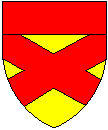
[Page updated August 31st 1998]
Back to the Glossary Contents
Originally these were a structural part of the shield, and can be shown as raised above the level of the background or field.
Ordinaries are the simplest form of charge. There are nine charges,some of which have diminutives, usually considered to be ordinaries:
The Quarter and Canton are usually included in the Sub-ordinaries.
A horizontal band across the top of the shield, conventionally occupying one third of the shield but usually drawn smaller, say one quarter the depth. A very common charge, the chief does not obscure other charges such as a bend or saltire. For example, or a saltire and a chief gules (Bruce).

Back to the Ordinaries menu
A horizontal band across the middle of the shield, conventionally occupying one third of the shield but usually drawn smaller, say one quarter the depth. A very common ordinary, often between two or three other charges, e.g. argent a fess between 2 lions passant gardant sable (Follyfoot).
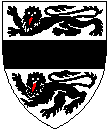
The fess dancetty is also common, e.g. a fess dancetty between 10 billets [different colours for different branches of the family] (Deincourt).

The diminutives of the fess are the bar (half the width) and the cotise (half a bar). A bar gemel is a double-bar treated as a single charge, e.g. argent three bars-gemels gules a lion rampant sable (Fairfax).
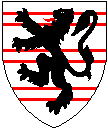
Back to the Ordinaries menu
A vertical band down the middle of the shield, conventionally occupying one third of the shield but often drawn smaller, say one quarter of the width. The pale (like other ordinaries) can be charged, for example argent on a pale sable a lucy’s head erect and couped or (Gascoyne).
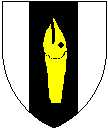
The diminutives of the pale are the pallet and endorse. An interesting use of the endorse is to flank the pale, e.g. argent a pale engrailed endorsed sable (?Bellasys).
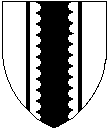
Back to the Ordinaries menu
A diagonal band running across the shield, derived from a military sash. The bend usually occupies about one third of the shield, and runs from top left to bottom right as viewed. A very common charge, especially in early heraldry. An example is or a bend azure (Carthorpe).
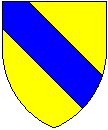
The diminutive of a bend is the bendlet. A bend cotised has a very thin subsidiary bend on each side of it. Bends frequently occur between two other charges, and can themselves be charged (in which case the charge runs with the bend or bendwise.)
A bend can run along the opposite diagonal, when it is termed the bend sinister.
Back to the Ordinaries menu
The chevron is one of the commonest ordinaries. A chevron is usually drawn thicker if there are no other charges or it itself bears charges (which are shown upright or erect.) The form is said to be derived from a rafter, and often occurs between 3 charges, as for instance in the Ergham arms argent a chevron between 3 martlets sable.
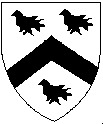
Chevrons can occur interlaced or braced. An example is azure three chevrons braced or, a chief of the last (Fitzhugh).

The diminutive of the chevron is the chevronel, though in practice the term chevron is normally used as for Fitzhugh above. Chevrons can be cotised or bounded with a very thin chevron to either side of the main charge.
Back to the Ordinaries menu
The cross is one of the commonest charges in heraldry. The simple cross has arms which reach the edges of the shield, and can be charged. The shape of a cross lends itself well to being placed between four charges. Crosses can be indented, engrailed and so on.
A charged cross is seen in the arms attributed to Brokenspeare, argent on a cross gules five mullets or.
Crosses are often depicted with ornamented ends to the limbs, and there are over a hundred different named types, although many are variations on a theme, for instance the differences between crosses paté, patonce and fleury are subtle. For example or a cross patonce sable (Vescy).
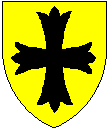
A cross which is pointed at the foot is said to be fitchy.
Crosses are also used as charges, e.g. argent a bend engrailed between two crosses moline gules and gules a cinquefoil between 8 crosses flory or, over all a bend engrailed argent (both Umfraville).
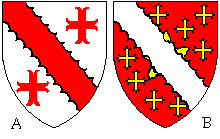
The diminutive of the cross is the crosslet, usually in the form of a cross crosslet which has the ends of its limbs themselves crossed. A field semy of crosses is said to be crusily.
Back to the Ordinaries menu
The saltire is a diagonal cross, formed by a bend sinister and a bend together. It is common, and like the cross lends itself to being between four charges. Saltires can have ornamented edges, for instance or a saltire engrailed sable (Botetourt).
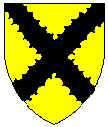
Back to the Ordinaries menu
The pile is a triangular wedge-like charge, usually though not invariably issuing from the top of the shield (if is from anywhere else it must be specified ‘...from dexter’ etc.). One cannot have a single pile issuing from the base as this would be the same as per chevron. The pile is not particularly common. There may be two, three or more piles on one shield, in which case they are drawn much narrower.
Argent a pile azure is shown below. I do not know whether this is a genuine shield.
Back to the Ordinaries menu
An uncommon charge in the shape of a Y. Normally the shakefork is shown with the ends of the limbs couped and pointed, and the pall or pairle with the limbs extending to the edges of the shield, but the matter is not clear-cut.
Azure a pall or is shown below. I do not know whether this is a genuine shield.
Back to the Ordinaries menu
Back to the Glossary Contents.
© Gill Smith 1997, 1998